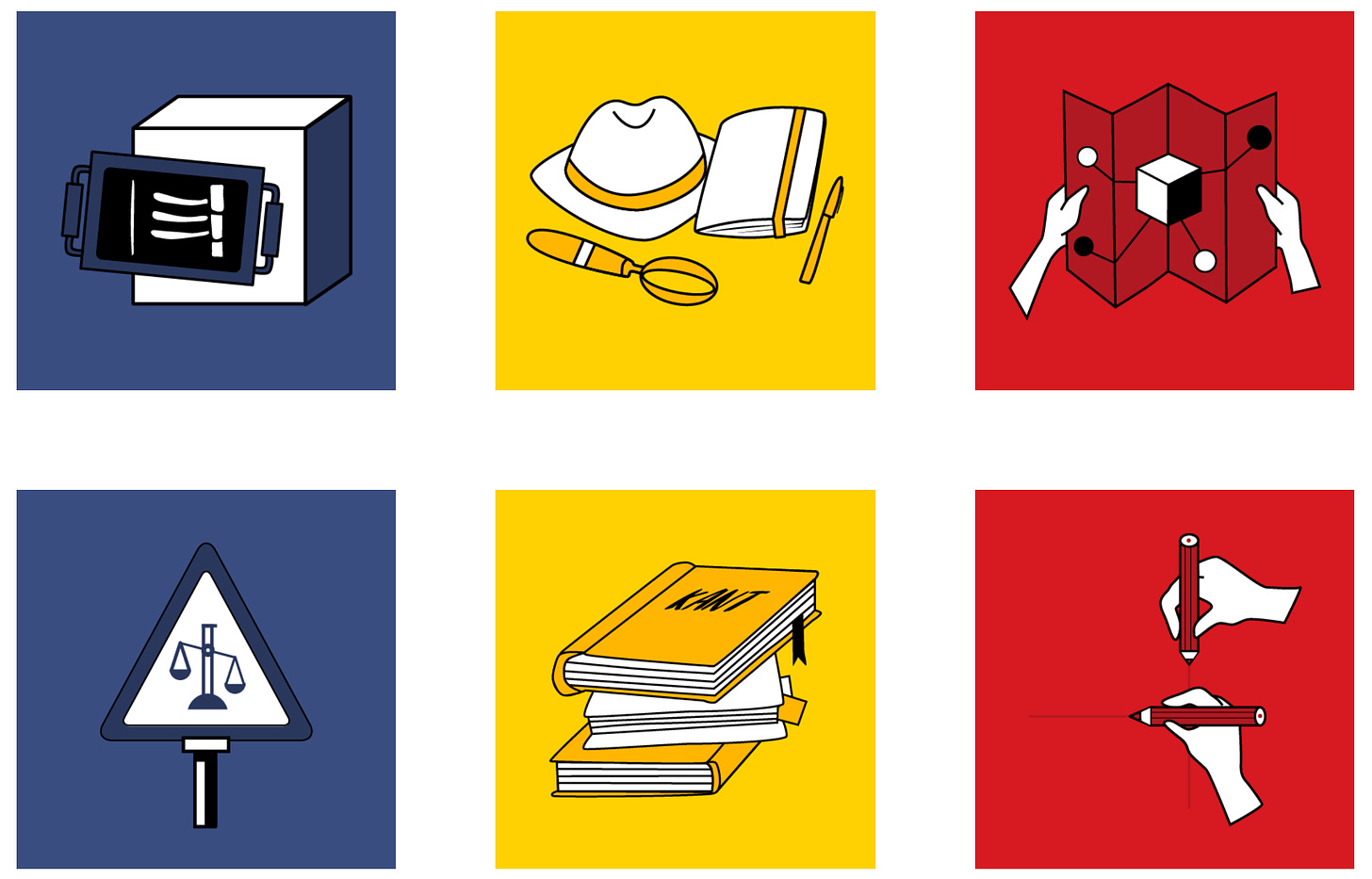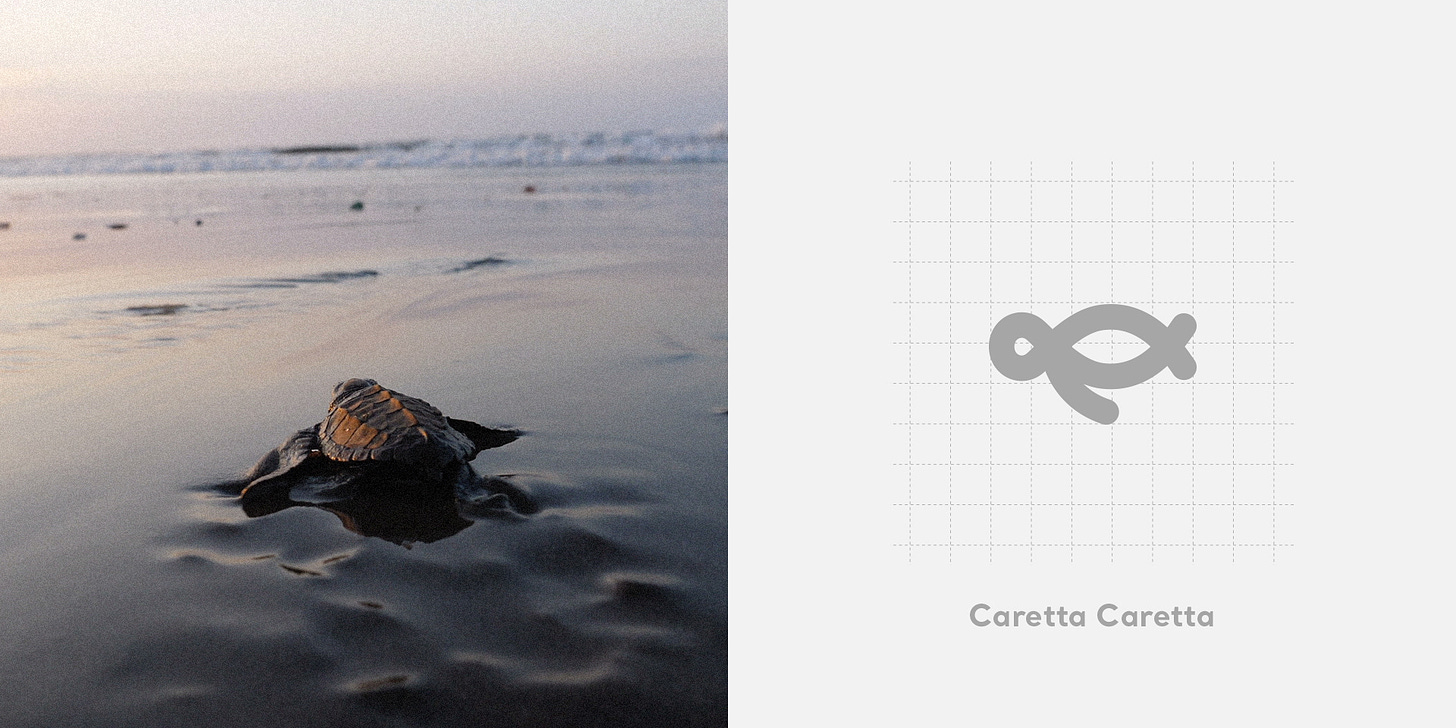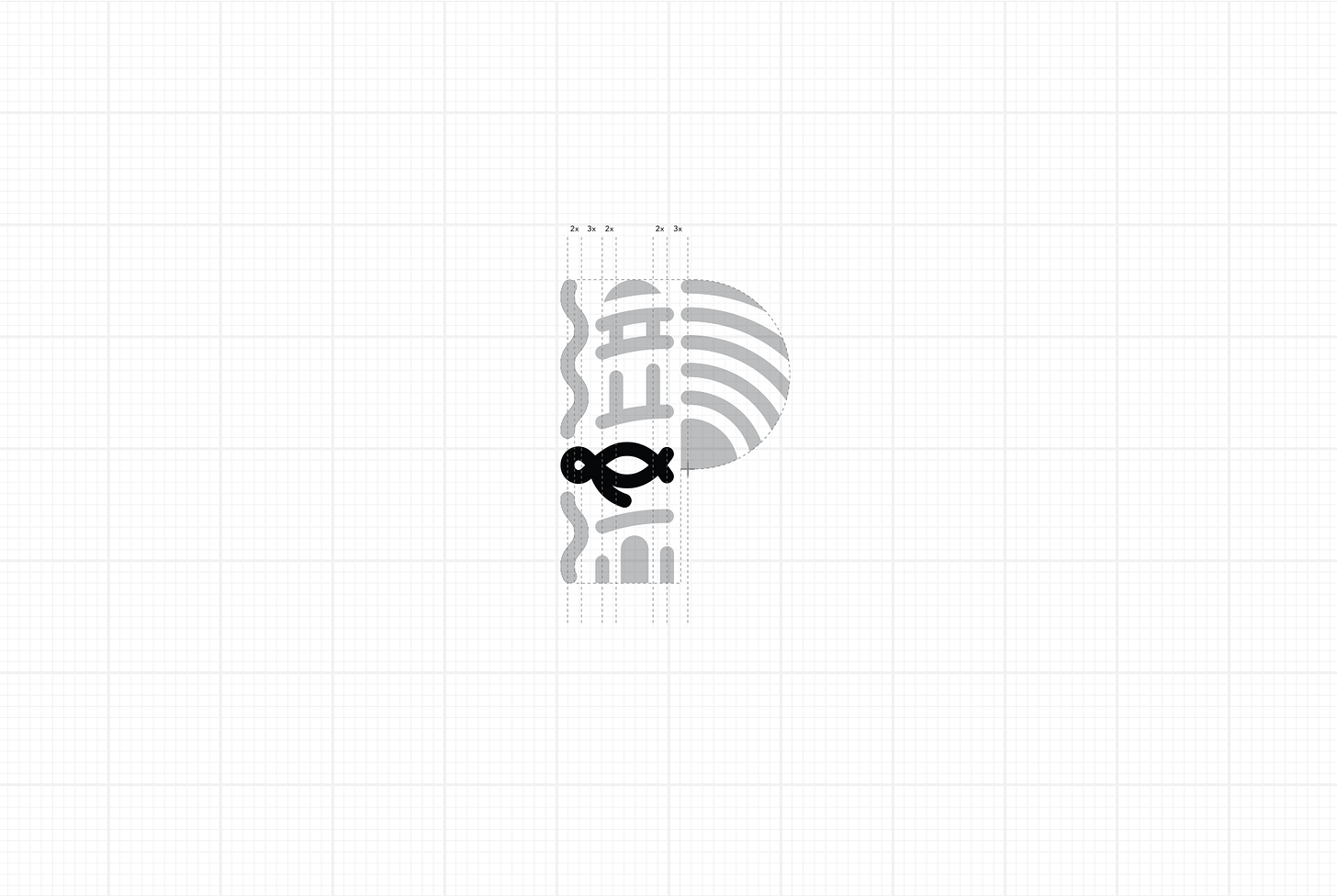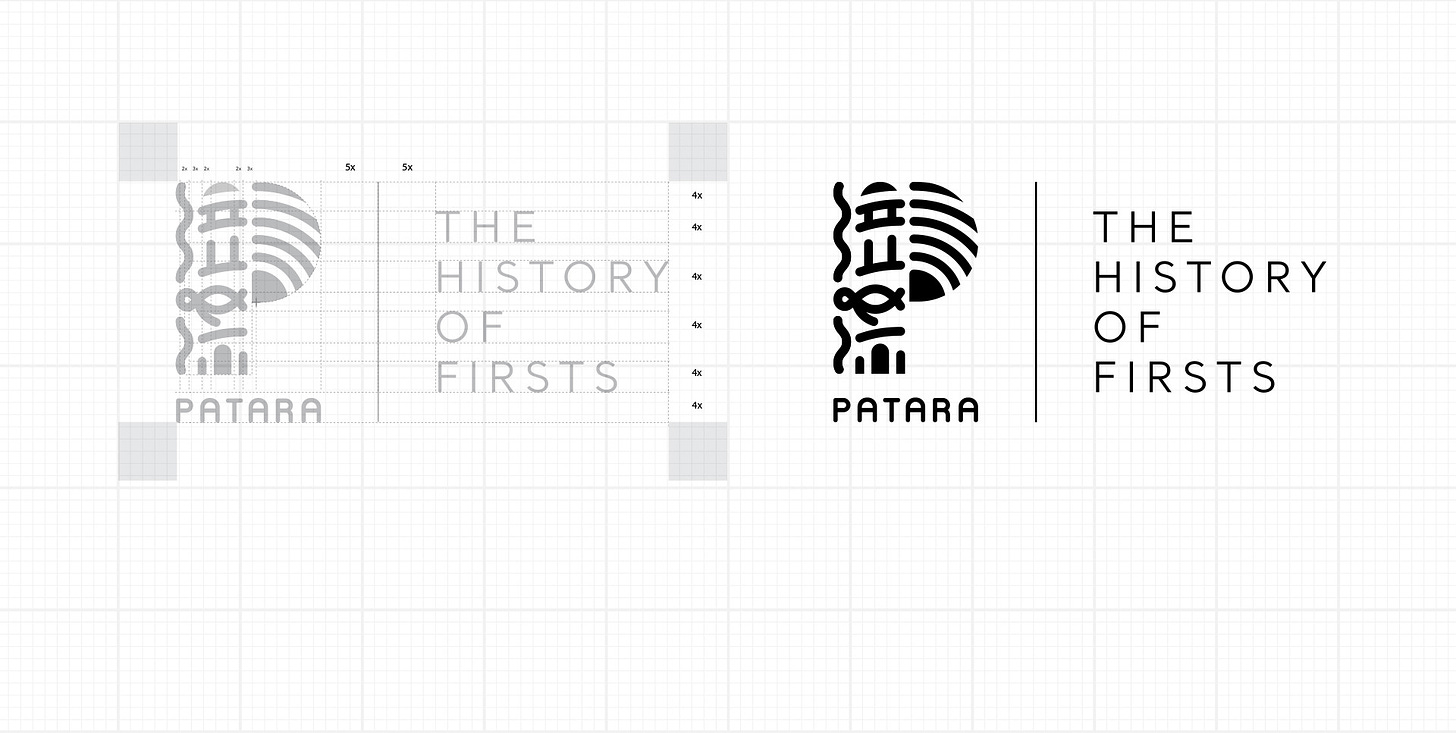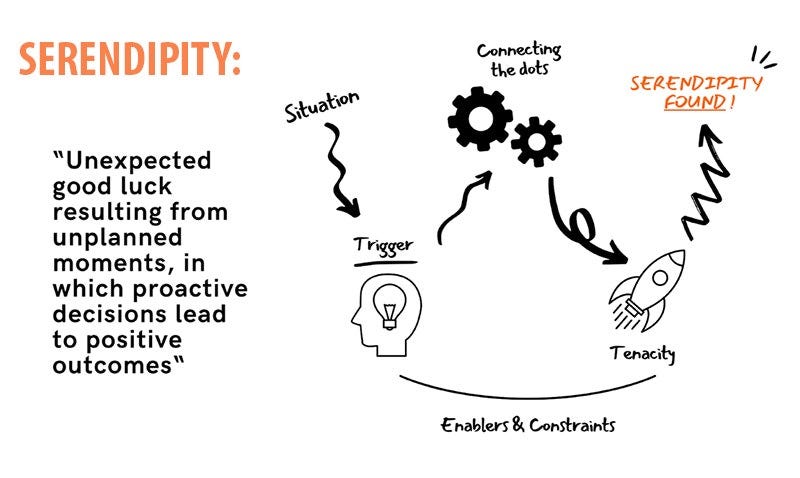Serendipity; seeing bridges where others see gaps, taking actions to create smart luck
Edition #024
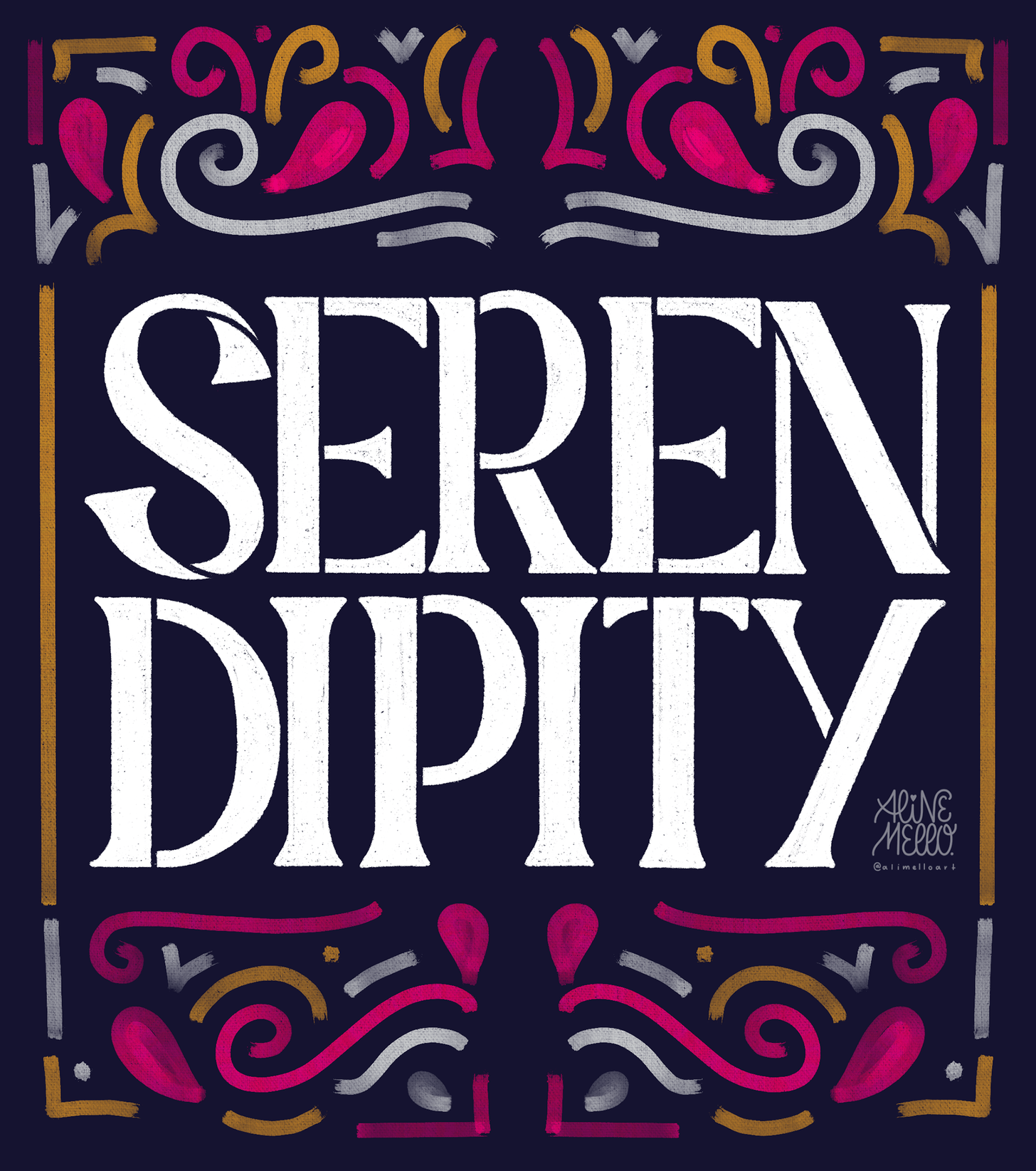
Serendipity is an unplanned fortunate discovery, it is a common occurrence throughout the history of product invention and scientific discovery
The first noted use of "serendipity" in the English language was by Horace Walpole on 28 January 1754. In a letter he wrote to his friend Horace Mann, Walpole explained an unexpected discovery he had made about a lost painting of Bianca Cappello by Giorgio Vasari by reference to a Persian fairy tale, The Three Princes of Serendip.
The princes, he told his correspondent, were "always making discoveries, by accidents and sagacity, of things which they were not in quest of." The name comes from Serendip, an old name for Sri Lanka (Ceylon), hence Sarandib by Arab traders.
The word has been exported into many other languages, with the general meaning of “unexpected discovery” or “fortunate chance”.
The term "serendipity" is often applied to inventions made by chance rather than intent. As Christian Busch describes serendipity in his Psyche article How to be lucky;
Most of us think that luck just happens (or doesn’t) but everyone can learn to look for the unexpected and find serendipity.
Human beings find comfort in certainty. We form governments, make calendars, and create organizations; and we structure our activities, strategies, and plans around these constructs. These routines give us the satisfaction of knowing that, by having a plan, there’s a means of it coming to fruition.
But there’s another force, constantly at play in life, that often makes the greatest difference to our futures: the ‘unexpected’ or the “unforeseen”. If you think about it, you already look out for the unexpected every day, but perhaps only as a defense mechanism. For example, whenever you use a pedestrian crossing on a busy road, you look out for the unexpected driver who might race through the red light. That “alertness” to, or awareness of, the unexpected is at the center of understanding the science of (smart) luck and exploiting it to your benefit.
Andrew Smith, editor of TheOxford Companion to American Food and Drink, has speculated that most every day products had serendipitous roots, with many early ones related to animals. The origin of cheese, for example, possibly originated in the Nomad practice of storing milk in the stomach of a dead camel that was attached to the saddle of a live one, thereby mixing rennet from the stomach with the milk stored within.
Other examples of serendipity in inventions include:
🗒 The Post-It Note, which emerged after 3M scientist Spencer Silver produced a weak adhesive, and a colleague used it to keep bookmarks in place on a church hymnal.
👨🔬 Silly Putty, which came from a failed attempt at synthetic rubber.
🎩 The use of sensors to prevent automobile airbags from killing children, which came from a chair developed by the MIT Media Lab for a Penn and Teller magic show.
♨️ The microwave oven. Raytheon scientist Percy Spencer first patented the idea behind it after noticing that emissions from radar equipment had melted the candy in his pocket.
🔬 The Velcro hook-and-loop fastener. George de Mestral came up with the idea after a bird hunting trip when he viewed cockleburs stuck to his pants under a microscope and saw that each burr was covered with tiny hooks.
🍭 The Popsicle, whose origins go back to San Francisco where Frank Epperson, age 11, accidentally left a mix of water and soda powder outside to freeze overnight.
💉 The antibiotic penicillin, which was discovered by Sir Alexander Fleming after returning from a vacation to find that a Petri dish containing staphylococcus culture had been infected by a Penicillium mold, and no bacteria grew near it.
ℹ️ The New York Times is still providing free access to the most important news and useful guidance on the coronavirus outbreak to help us understand the pandemic. Here are the latest updates and maps of the outbreak.
Remote jobs
💯 Global remote design jobs without geo-restrictions.
Automattic is looking for;
MURAL is looking for;
Upwork is looking for;
TED Conferences is looking for;
Clearbit is looking for;
Lulafit is looking for;
Hopin is looking for;
Andela is looking for;
Sourcegraph is looking for;
Near is looking for;
Sure is looking for;
Smedia is looking for;
Play Solutions is looking for;
Junior Positions & Internships
Everyday Health is looking for;
FastStartup is looking for;
RMG is looking for;
Alpaca Travel is looking for;
Decent Labs is looking for;
Vydia is looking for;
Flytedesk is looking for;
Lee Enterprises is looking for;
VerteXD is looking for;
Bold Type LLC is looking for;
Dwolla is looking for;
Way Creative House is looking for;
Dwolla is looking for;
Chegg is looking for;
Education Partner
You should not take any risks with your design education when you want to learn and advance your career. Your course content should be evidence-based and valuable to your job.
On this mission, we partnered with the Interaction Design Foundation, the World’s leading online design school with serves peer-reviewed, evidence-based educational materials, and industry-recognized course certificates.
Trusted by IBM and Adobe who train their teams with IDF courses, you can also enroll now through our collaboration and get 3 months off your yearly membership to make a life-changing shift into UX design or stay ahead.
Tools & Resources
✨ Ethical tools for designers
These tools will help you uncover, explore and discuss the ethical aspects of your designs. The tools are grouped based on the skill they help you develop and can be used in different phases of the design process. On the website, if you click on a tool you'll find the materials and instructions you need to get started right away.
🧐 The Universal Score is a framework for evaluating inclusion and belonging. Use it to think critically about how inclusive your decisions are, so you can design and build a better experience that works for everyone. Choose a product, service, or journey to test with a series of questions on 5 areas of inclusivity: mental wellbeing, belonging, physical needs, neurodiversity and putting people first. Then get your final score with practical recommendations to help you raise your game.
🃏 Cards for Humanity is a practical tool for inclusive design, which deals you two random cards, a person and a trait. Your challenge: work out how you can meet their needs.
🎶 Echoes is a new web app for discovering your music streaming stats and more amazing music. You can get insights into your music listening habits with top artists and tracks. Discover new music, create playlists and get monthly reports.
🌳 Forest is an app helping you stay away from your smartphone and stay focused on your work. Forest team partners with a real-tree-planting organization, Trees for the Future, to plant real trees on Earth. When our users spend virtual coins they earn in Forest on planting real trees, the team donates to our partner and creates planting orders.
🌎 Flatten the Curve by SafetyWing provides containment measures, testing and treatment information, and travel restrictions around the globe. Are you waiting on a country to open to travel? Or perhaps concerned a country you are planning to go to will close it's borders? They recently added the ability to sign up for email updates on country openings/closures. Just head to flattenthecurve.global and click on the "Get updates" tab at the bottom.
🧠 Humane by Design is a resource that provides guidance for designing ethically humane digital products through patterns focused on user well-being.
🔎 FontShare provides high-quality, professionally crafted free fonts for your personal and commercial projects.
📕 Stark Public Library, becoming the largest, centralized accessibility resource on the internet. Discover the world's best a11y info, guides, events, courses, and more—curated & created for you.
🎞 Flow is a professional animation software, for iOS, Web, and Lottie. Import from Sketch or Figma, animate with our powerful timeline editor, generate production-ready media, or code, that your devs will love to work with.
🗣 Useberry gets user testing feedback & rich insights in minutes, not months!
📣 Olvy lets you announce new features with beautiful and effective release note standalone pages and in-app widgets.
Explore our ever-growing website with 1500+ design tools and resources.
Reading
▪ The State of Design
Abstract
▪ The Scary Future of Instagram
Growth Design
▪ 5 thinking tools to add to your metacognitive toolbox
Anne-Laure Le Cunff | Ness Labs
▪ Fjord Trends 2021
Mark Curtis & Martha Cotton | Accenture Interactive
▪ Sleep equity: good for night owls and early birds
Mike Sholars | Dropbox Blog
▪ The hidden cost of design complexity
Julien Zmiro | Inside Intercom
▪ The ethics of UX: when is it good design and when are you just tricking people?
Mimi Launder | DigitalArts
▪ Why remote work may render the 5-day workweek obsolete
Scott Dust | Fast Company
Talks
Randy Pausch Lecture: Time Management
Carnegie Mellon Professor Randy Pausch gave a lecture on Time Management at the University of Virginia in November 2007.
Randy Pausch is a virtual reality pioneer, human-computer interaction researcher, co-founder of Carnegie Mellon's Entertainment Technology Center, and creator of the Alice software project. The slides for this lecture and high-res downloadable versions of this and other lectures can be found at here.
Mind the gap, user-centered design in large organizations with Luke Wroblewski
Great talk from LukeW, who is currently working at Google as a Product Director.
Branding Inspiration
Patara - Branding
In order to promote tourism in Turkey, 2020 was declared the Year of Patara. Patara harbors a richness that is hard to find in the world where history and nature are intertwined. Therefore, it is very difficult to reduce Patara to a single icon or to try to describe Patara with a single icon.
Developed by Ogilvy Istanbul and designed on the basis of Patara's initial letter, the logo symbolizes Patara's historical and cultural richness. The wave on the longest side of the logo represents a magnificent beach. The miracle journey of Caretta-Caretta’s is also immortalized within the logo. The rest consists of the parliament building where important steps of the pluralist management model were taken, the lighthouse symbolizing the maritime trade and the entrance gate of the city stand out as cultural assets owned by Patara in an aesthetic composition.
You can see more visual assets, review the credits in the Behance project.
What happened
Twitter recently announced it’s bringing the full-service creative agency Ueno in-house to work alongside Twitter’s own design and research teams.
The move, an acquire of sorts, is one where Twitter is essentially buying the agency with which it already had a close working relationship, as Ueno had previously partnered with Twitter on various design and product experiences in the past.
The company also acquiring newsletter publishing company Revue, a newsletter platform for writers and publishers. The deal marks Twitter's first step into building out long-form content experiences on Twitter and its first foray into subscription revenue.
Alphabet is grounding Loon. After 9 years of surfing the stratospheric winds, Loon’s journey is coming to an end.
After a decade of pursuing high-altitude hot air balloons as floating cell towers, it said it doesn't see a way to get costs down to make Loon a viable business.
Project Loon will be winding down operations and its remaining balloons in the coming months while employees are shuffled across Alphabet, Google, and X.
Dropbox is cutting its global workforce by about 11%, the company said in an 8K filing released.
The company also announced that Chief Operating Officer Olivia Nottebohm left Dropbox on Feb. 5.
Google workers across the globe announce an international union alliance to hold Alphabet accountable.
Google workers across the world are coming together to form a global union alliance. The newly formed coalition, called Alpha Global, is comprised of 13 different unions representing workers in 10 countries, including the United States, United Kingdom, and Switzerland.
Spotify has been granted a patent with technology that aims to use recordings of our speech and background noise to determine what kind of music to curate and recommend to us, Music Business Worldwide reports. The company filed for the patent in 2018; it was approved on January 12, 2021.
The streaming platform is interested in extracting data points like emotional state, gender, age, and accent to hone its recommendations.
Adobe has shipped the first version of Photoshop that can run natively on Macs equipped with Apple Silicon and also has announced a new feature for Adobe Camera Raw (ACR) called “Super Resolution” that is available now.
Super Resolution is a new feature to Adobe Camera Raw that uses machine learning technology to boost the resolution of an image, resulting in “higher quality results than ever before.”
Amazon expands its gamification program that encourages warehouse employees to work harder. The program, FC Games, is expanding to at least 20 fulfillment centers in the US.
Amazon’s demanding productivity quotas have also created safety crises by pushing delivery drivers and warehouse workers to the brink. It has also preserved its unsafe working conditions during the pandemic and often forced workers across its sprawling empire to work without adequate protections. Thanks to its monopoly and monopsony powers, however, the company has largely avoided any consequences for this. Read more.
Looking to immersive yourself into the world of art and history from the comfort of your home? Well, the Musée du Louvre has just made its entire art collection available online. You can view over 480,000 artworks, ranging from Islamic art and renaissance sculptures to Egyptian antiquities and paintings from artists all over the world.
Major institutions have been digitizing their collections for many years, but the Louvre's online archives required especially exhaustive labour. Every image, according to the museum, is accompanied by scientific data: title, artist, inventory number, dimensions, materials and techniques, date and place of production, object history, current location and bibliography.
Apple’s Worldwide Developers Conference is back in its all-online format, WWDC21 developer conference will be held in AR and VR only, kicks off online beginning June 7, 2021.
Free for all developers, WWDC21 will offer unique insight into the future of iOS, iPadOS, macOS, watchOS, and tvOS. Building on the record-breaking participation and learnings from last year’s online conference, WWDC21 is an opportunity for developers to learn about the new technologies, tools, and frameworks they rely on to build innovative and platform-differentiating apps and games.
Apple also announced that this year’s Swift Student Challenge, an opportunity for young developers to demonstrate their coding skills by creating a Swift playground, is now accepting submissions. Submissions for the Swift Student Challenge are open now through April 18.
The Star Wars Vintage Collection brings classic cartoons and shows to Disney Plus.
Return to Genndy Tartakovsky’s 2D animated Clone Wars. Disney Plus is getting a big influx of classic Star Wars shows and movies in the newly added “Star Wars Vintage Collection,” which brings retro Star Wars content to streaming. It’s also the first time any piece of The Star Wars Holiday Special has been broadly released since the original airing in 1978.
So what to do?
Even being open to the unexpected is the key to create smart luck, there is another force in play: preparation.
This is partly about removing the barriers to serendipity, both mental (your mindset) and physical (the spaces you live and interact in), such as: overloaded schedules; senseless meetings; and the inefficiencies throughout your day that rob you of time, curiosity and a sense of joy.
You can prepare by strengthening your mental readiness to connect with opportunity, and creating an environment that enables the use of your skills and available resources to act on the moment. An unprepared mind often discards unusual encounters, thereby missing the opportunities for smart luck.
✤ Accept that the unexpected happens all the time to start ‘seeing’ good things over bad and begin to view them as a potential benefit or opportunity rather than a threat.
✤ Resist your urge to find familiarity in the unknown, and to control anomalies. If you continually airbrush the many unexpected events out of your (hi)stories, you’ll miss the importance of the unpredictable parts and therefore fail to recognise – let alone legitimise – the critical role that serendipity will play in your future.
✤ Having the mental agility to improvise, to see how a tool could be used in a new way, is essential to building your serendipity mindset. Your own creativity will thrive when you abandon the physical and mental tools with which you’re most familiar, and find new ways to work or think.
✤ If you are new to journalling, don’t overthink it. Set a timer for two minutes, then list out in two columns the parts of your day that led to positive outcomes and the parts of the day that did not. As you break down your day into these segments, examine the parts that worked really well for you, and the ones that were inefficient, stressful or unfulfilling.
✤ We lead unique and complex lives. If you clean up the minutiae, they’ll no longer take up space in your daily life, and you’ll have more cognitive, emotional and physical attention to dedicate to the more important stuff. Declutter your life.
✤ Try ‘reframing’ mistakes, challenges, and setbacks as opportunities. What appeared to be ‘bad luck’ in the moment turned into ‘good luck’ by reframing the situation.
Serendipity is a process. It’s an opportunity to turn chance into good fortune through your own efforts, which doesn’t always happen in a flash. It often requires an incubation period. Be patient, knowing that some of your efforts could result in an immediate spark while others will be more like planting seeds, for which the fruits of your labour will pleasantly surprise you in the future.
Learn more
Christian Busch’s bookThe Serendipity Mindset: The Art and Science of Creating Good Luck (2020) is the first comprehensive science-based approach on how to cultivate serendipity – ‘smart luck’.
In this online talk for the American Psychological Association from 2020, he discussed how the science of serendipity can help turn uncertainty into opportunity.
In this article for the World Economic Forum, he showed how new business models and opportunities are emerging in the wake of COVID-19 uncertainty.
In this article for LSE Business Review, Harry Barkema, a professor of management, and Christian Busch discuss how, in the context of extreme resource constraints, reframing is possible – and what we can learn from social entrepreneurs in Sub-Saharan Africa.
In this article for the Harvard Business Review, he explains how to set ‘serendipity bombs’ and cast ‘serendipity hooks’ in order to cultivate serendipity.
— That’s it for this edition. Here is a hand-picked collection of the best product management and UX conferences in 2021. See you next month.





